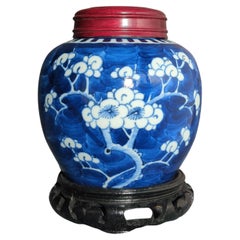Chinese Ginger Jar 5
Antique 19th Century Chinese Chinese Export Ceramics
Porcelain
People Also Browsed
2010s Indian Organic Modern Decorative Dishes and Vide-Poche
Bronze
21st Century and Contemporary Italian Mid-Century Modern Wall Mirrors
Brass
Vintage 1960s Danish Mid-Century Modern Vases
Ceramic
20th Century Chinese Qing Patio and Garden Furniture
Ceramic
Antique 15th Century and Earlier Hong Kong Tang Antiquities
Earthenware
Antique 19th Century Chinese Jars
Crystal, Other
Mid-20th Century Argentine Wall Mirrors
Glass, Giltwood
Antique 18th Century Peruvian Spanish Colonial Cabinets
Mother-of-Pearl, Teak
Antique 15th Century and Earlier Malagasy Natural Specimens
Other
Mid-20th Century Indian Anglo Raj Decorative Boxes
Multi-gemstone, Metal
20th Century Korean Mid-Century Modern Animal Sculptures
Brass
Antique 1890s Japanese Meiji More Asian Art, Objects and Furniture
Copper
20th Century Chinese Chinese Export Jars
Porcelain
Mid-20th Century Ceramics
Ceramic
Antique 19th Century Chinese Qing Scholar's Objects
Jade
20th Century International Style Antiquities
Ceramic
Chinese Ginger Jar 5 For Sale on 1stDibs
How Much is a Chinese Ginger Jar 5?
A Close Look at Chinese-export Furniture
Expanded trade between Europe and East Asia, starting in the 16th century, led to a booming market for exported goods, particularly furniture. This was bolstered by the establishment of the Dutch and English East India Companies at the beginning of the 17th century. From folding screens and chairs to lacquer tables and silver, Chinese Export furniture was in demand and regularly copied and imitated, leading to styles like chinoiserie and Chinese Chippendale.
The expansion of exporting that had strengthened the arts during the Ming dynasty continued into the Qing dynasty era — Chinese designers made many furniture pieces specifically for export, resulting in distinctive designs that mixed traditional techniques with forms appealing to foreign buyers. For instance, cabinetmakers in Canton (modern-day Guangzhou) were prolific in crafting hardwood furniture for export in European styles that involved the expert joinery techniques of Chinese furniture. Designs for Chinese Export porcelain, cabinets, decorative objects and other furniture were often more ornately adorned than they would be for a local audience, such as with mother-of-pearl overlays or surfaces featuring lavish pictorial scenes or gold on black motifs. Some were even commissioned by wealthy European families to be adorned with their coat of arms.
Because lacquer furniture was especially prized, and the resin used to create it was difficult to import as it would harden during the long voyage, artisans in China and Japan exported numerous lacquer pieces. Long before lacquer made its way to Japan, the Chinese treated the material differently. They used it to create smooth, glossy surfaces, but also for carving, an art that began in the 12th century and is exclusively Chinese. These pieces are called cinnabar lacquer after the powdered mercury sulfide (cinnabar) employed to produce their characteristic red hue. A popular form for export was a compact cabinet with drawers, usually displayed on a small table. Undecorated furniture built in Europe was also shipped to China to be lacquered. The international exchange of design would influence furniture into the 19th century and later, informing styles such as Art Deco and Art Nouveau.
Find a collection of antique Chinese Export tables, beds, cupboards, table lamps and more furniture on 1stDibs.
Finding the Right Ceramics for You
With their rich and diverse history, antique, new and vintage Asian ceramics offer colorful and sophisticated ways to add flair to any space.
Japanese pottery dates back at least 13,000 years to the Jōmon period. Pieces from the Late Jōmon era display a rope-cord pattern encircling a pot or jug. During the Muromachi period, potters created simple bowls and utensils frequently used in tea ceremonies and were made as both functional and aesthetic objects.
Ceramics made during Japan’s Meiji period, from 1868 to 1912, reflected an explosion of artistic expression propelled by new access to international trade. Details became more intricate and refined, and colors were enhanced with new glazing practices.
Chinese porcelain, meanwhile, is often identified by its shape. Each reign and dynasty had specific shapes and styles that were encouraged by the imperial ruler. During the Song dynasty, for instance, there were four dominant types of ceramic vase shapes: plum-shaped, pear-shaped, cong-shaped (tall and square) and double-gourd.
Chinese ceramics that were made during the Qing dynasty were demonstrative of an expanded artistic expression, with more delicate shapes and a focus on intricate detailing. The shapes of ceramics from this era are thinner, taller and have subtle features like a gentle flare, such as on the mallet-shaped vase.
Later, the 17th- and 18th-century interior design trend of chinoiserie brought Asian paintings and screens, textiles and other art and furniture from the continent into many European homes.
Explore an extensive range of antique, new and vintage Asian ceramics on 1stDibs to find the perfect piece for your home.
 Lotus GallerySeptember 23, 2020
Lotus GallerySeptember 23, 2020Chinese ginger jars were originally made as utilitarian vessels used to store various herbs and spices. Today, they are almost exclusively decorative objects.
 Lotus GallerySeptember 23, 2020
Lotus GallerySeptember 23, 2020Chinese ginger jars are defined by their round, compact shape, wide mouth, short neck, and fitted cover.
 Lotus GallerySeptember 23, 2020
Lotus GallerySeptember 23, 2020A Chinese ginger jar should be fairly compact in size, with a rounded, globular or ovoid body, high shoulders, a wide circular mouth, short neck, and a fitted cover.
